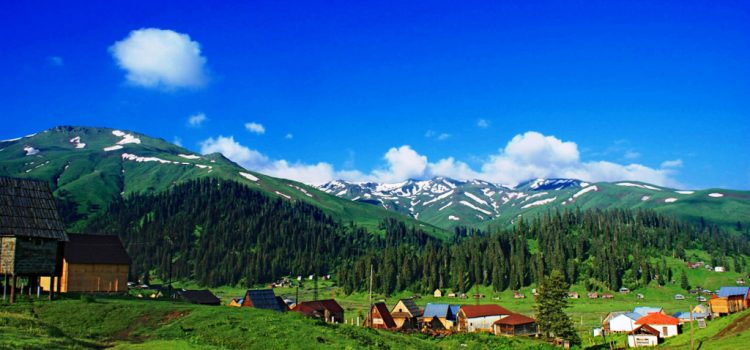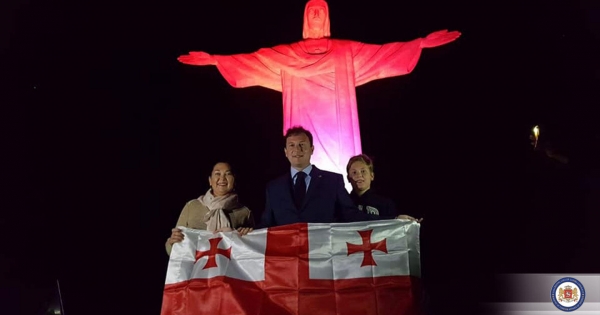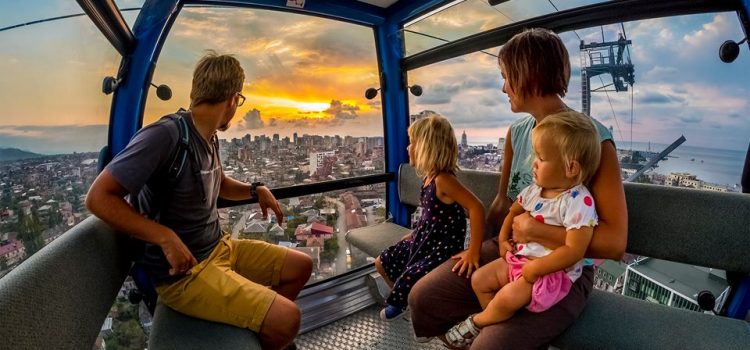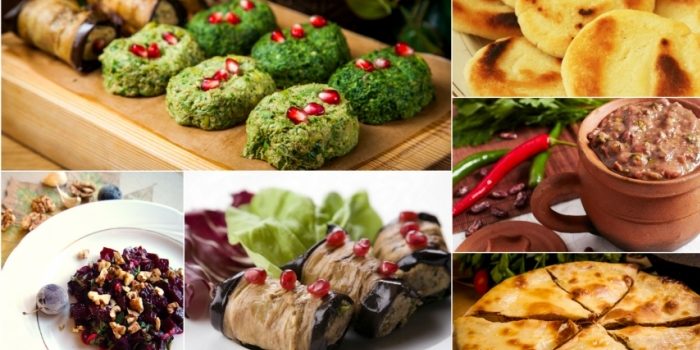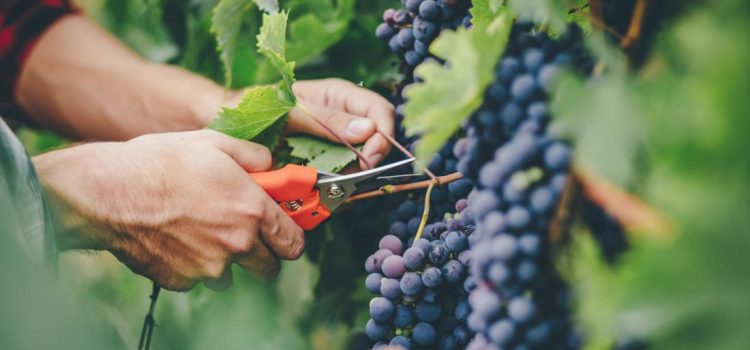The International Folk Festival
.
The International Folk Festival is set to kick off for the third time in Georgia. Under the scope of the government’s Check in Georgia program, the Black Sea Arena is to host the annual cultural event on September 7-9. The music celebration will be opened on the 7th with united concerts of Georgian and European ensembles.
Folk singers and dance ensembles from Georgia and abroad will be presented to listeners in Shekvetili. The festival follows perfectly Georgia’s reputation for preserving cultural heritage. This time round, the International Folk Festival features representatives of even more countries: France (Corsica) will be presented by Spartimu and Italy (Sardinia) by the Castelsardo ensemble.
Georgia will be introduced to the Black Sea audience by the following performers: Bermukha (Ajara); Shilda (Kakheti); Trio ‘Shalva Chemo’ (Guria); Riho (Svaneti); Basiani and Kartuli Khmebi (Tbilisi); The State Song and Dance Ensemble of Kutaisi; Enver Khabadze State Choreographic Ensemble ‘Batumi.’
On July 30, a press conference was held in the garden of the Folklore Center, attended by the Executive Director of the Folklore Center, Giorgi Donadze, Head of Black Sea Arena, Tato Kharchilava and Director Nikoloz Heine-Shvelidze.
The festival aims to support the popularization and preservation of Georgian folklore. Georgia, the homeland of polyphony and ever better-known for its extraordinary traditions and its people’s outstanding ability to sing and dance, in September is grabbing the opportunity to host other nations with equally important traditions of different styles of folk music. With numerous emerging musical genres, it is important to remember where it all started. That is why Georgia is ambitious to make its own land the location of an annual meet up for Georgian and worldwide folk music.
When done at the Black Sea Arena, the festival will carry on, traveling to the mountainous region of Racha, where united concerts of Georgian and European ensembles will be performed in Oni and Ambrolauri. This time, Georgia will be presented by ensembles Pesvebi from Adjara, Shilda from Kakheti, Shalva Chemo from Guria, Iavnana, Sagalobeli, Racha, Salaghobo from Lechkhumi, Lile, Lagusheda from Kvemo Svaneti, Dziriani, and Basiani from Tbilisi. The closing performance of the festival will be given by Georgian Ethno Jazz group ‘Egari’.
The continuation of the International Folk Festival scheduled in Racha will also feature four foreign ensembles. “Spartimu” from France, “Castelsardo” from Italy, “Koniakow” from Poland, and “Ackups” from Latvia. Seminars will be led by famous ethnomusicologists Polo Vallejo and Renato Morelli. For foreign and local guests, masterclasses will be given by Giorgi Donadze, Levan Berelidze and Professor Natalia Zumbadze.
Tickets will be available on tkt.ge.
Source: www.georgiatoday.ge; By Nini Dakhundaridze
Photo source: www.Georgiatoday.ge
Bakhmaro – Unique resort with healing properties
Bakhmaro located in Guria (western Georgia) is one of the healthiest resorts of the country. It lies on the Bakhvistsqali River. Bakhmaro is distinguished by the combination of alpine and marine climate. It is situated 1950-2050 meters above sea level. This is the highest alpine climate resort in Georgia. The resort abounds with spruce, pine and fir trees.
All the mentioned features make Bakhmaro a magical place for many people with health problems especially those with lymph, respiratory diseases and anemia. Besides its heavenly landscape, beautiful pine forests, alpine meadows and amazing views the area are notable for its small cute cottages that are scattered throughout the green valleys with a river flowing through them.
It is believed that visiting Bakhmaro will make your immune system stronger. Its clean and transparent air speeds recovery from illness. Two centuries ago a shepherd diagnosed with tuberculosis visited the area (before the resort was discovered and named) and recovered from the disease. At that time, people thought it was a miracle but later the unique properties of the area were discovered and it was named the resort Bakhmaro.
Source: www.Georgianjournal.ge
World sights illuminated in the colors of the Georgian flag
Georgia celebrated the Independence Day on the 26th of May. The annual public holiday commemorates the 26 May 1918 adoption of the Act of Independence.26 May had been celebrated as a public holiday until Georgia became part of the Soviet Union in 1922.
Celebrations of regional public holidays were suppressed across the Soviet Union and it wasn’t until 1991, with the collapse of the Soviet regime that this day regained its public holiday status.
The government of Georgia organizes military parades, concerts, fairs, and various public events celebrating the history and culture of Georgia annually on Georgia’s Independence Day.
The famous landmarks around the world were illuminated in the color of the Georgian flag in order to commemorate the 101st anniversary of the country’s independence. The famous statue of Jesus on Mount Corcovado in Brazil, a historical bridge in Vilnius and the Christ’s Resurrection Church in Kaunas were illuminated on the 26th of May. According to the Ministry of Foreign Affairs of Georgia, the event will contribute to Georgia’s popularization across the world.
Besides, a concert and international cultural day took place in Stuttgart, Germany dedicated to the Independence Day of Georgia. The Georgian ensemble `Fesbebi` from New-York, Georgian Cultural center `Lazi` from Paris and the Georgian dancing ensemble `Medea’ from Antwerp along with various Georgian artists and musicians participated in the event.
The Georgian flag was festively raised, the anthems of Georgia and the USA and Georgian dances and songs were performed in Philadelphia in the commemoration of the Independence Day. The convention center was illuminated and the Georgian flags were showcased in the central part of Dublin, Ireland.
The Czech Republic hosted the performance of the Georgian ensembles and the exhibition of the Georgian national clothes. The festive events dedicated to the day took place in Denmark and Iceland as well.
source: Georgianjournal.ge; Photo: Georgianjournal.ge
Tour guides or foreign agents – what is happening in Georgia?
Nino Burchuladze and Nino Tsipuria, the journalists of Kviris Palitra, headed for the touristic centers of Tbilisi (the capital of Georgia) in order to find out more about the positive and negative sides of tourism in Georgia. They met tourists, local workers, vendors and listen to their views about the touristic situation in Tbilisi.
The first respondents were a group of Chinese tourists. They told the journalists that they liked Tbilisi and Batumi, a seaside city in south-western Georgia the most. According to them, Georgia is a well-known country in China. The only things they don’t like in Georgia are salty dishes and the lack of speedy trains. They hope Georgia and China will more deepen their relationship in the future.
Going up the Narikala fortress in Tbilisi, the journalists decided to have a conversation with local workers. They said that there are guides who fabricate stories about Georgia or provide wrong information to the tourists. They believe guides should be well-educated local people who have a good knowledge of Georgian history. There are various foreign touristic companies that don’t bring any financial profit to locals. They hope the government will impose certain regulations in this regard.
The next destination was the outdoor markets. The local vendors are impressed with the high number of tourists in Georgia. They hope it will increase in the summer. However, they are also concerned about the lack of Georgians’ involvement in local tourism. According to them, there are Arabian and Iranian guides who lie about Georgia saying that it is part of Iran or Saudi Arabia. As for tourists, they observed that Russian tourists have a very negative attitude and tend to look down on the vendors. The most positive and warm tourists are Ukrainians, Europeans, Arabians, and Americans.
Source: Georgianjournal.ge
Why Tbilisi’s One of My Favorite Cities in the World
THERE ARE CITIES that make sense. The streets glide along straight, clean lines, their names uniform from start to finish. Bridges are crossable. Signs point in the proper direction.
Then there’s Tbilisi.
Riotous and anarchic, the capital of Georgia is anything but organized. Locals use Soviet-era street names—Leselidze, Davitashvili, Perovskaya—found only on decades-old maps. Wine is sold in repurposed Coca-Cola bottles for a dollar a liter from boulevard underpasses. The electricity still cuts out in the heart of the “Kala,” Tbilisi’s historic old town.
Despite this—maybe even because of it—this city is one of the best, most strikingly original travel destinations in Europe or Asia, if not the world.
Pop into an unmarked courtyard near the Armenian Norashen Church—overgrown with ripe pomegranates—and find yourself among well-fed stray cats in a bohemian artist’s studio (one of the workers may invite you for home-brewed, noxiously alcoholic chacha; he will not let you refuse, nor should you wish to).
Sneak into the basement of the red-brick seminary across from Sioni Cathedral and buy Tbilisi’s best bread—dough thrown against the scalding sides of a circular tone oven—from an elderly kerchief-wearing woman for 30 cents a loaf.
Head up a slanting set of town house stairs in the fin de siècle neighborhood of Sololaki and find yourself in a speakeasy-style apartment café called Linville, where tables hide behind vines on wrought iron balconies and afternoon tango milongas take place under decorative Victorian parasols.
Slip across the Dry Bridge, past the ruined frescoes of the former Grand Hotel, to the flea market and bargain with bearded ex-professors for wooden icons, Soviet-era gas masks, and Turkish tea glasses. Come more than once and the vendors will remember you (I buy my jewelry—traditional Georgian enameling—from the same seller every year; she recalls not just my taste, but that of the mother and grandmother I purchased gifts for).
The cliché, of course, is that Tbilisi represents the epitome of East meets West: a Silk Road crossroads where Arab, Ottoman, Mongol, and Russian imperial forces each left their own distinctive cultural mark. And in the heart of the old town, where rugs dangle from whitewashed wooden balconies and bearded Georgian Orthodox priests jostle with tourists on narrow cobblestone streets, it’s a compelling fantasy.
But the city’s reality is far more complicated—and intoxicating.
“East” and “West” are all but meaningless terms here, where the ancient fortress lording over old town has been used both by and against each set of conquerors, where the horizon—and the snowcapped Caucasus beyond—is punctuated by smoky Soviet tower blocks.
On Grishashvili Street, near the sulfur bathhouses—traditionally staffed not by ethnic Georgians, the by-far majority in this famously tolerant city, but by Muslim Azeris—a half-hidden chaikhana, or teahouse, serves baklava at carpeted banquettes before an open fire. A five-minute walk along the Kura River leads to Tartine—a French brasserie popular with expats and well-heeled locals alike—and café au lait delivered in gargantuan bowls. And at KGB, a restaurant whose tagline is “We’re still watching you,” Soviet kitsch takes on a hipster vibe.
Not all locals are as gleefully tongue-in-cheek about their city’s past, however. Shopping at the bazroba (bazaar), or feasting on caraway-spiced khinkali meat dumplings in wood-paneled working men’s taverns, you’re as likely as not to be dragooned into someone’s rhapsodic ode—in a mixture of Russian, Georgian, English, and fervently expressive gesturing—to the beauty of the mountains, the Virgin Mary, Mother Georgia, the tradition of hospitality, or women who happen to be in the vicinity.
Still, if Tbilisi has an aesthetic, it’s “retro collage.” Hidden bars like O Moda Moda—which doubles as a vintage clothing atelier—offer mulled wine and cocktails alongside traditional tarragon lemonade and syrupy Lagidze nectars served from massive soda fountains. Tbilisi’s most iconic eatery, Purpur, is a collection of mismatched tablecloths, 19th-century lamp shades, and crumbling flea market bric-a-brac.
But few places capture Tbilisi’s energy like the city’s hottest new restaurant, Café Littéra—brainchild of new celebrity chef Tekuna Gachechiladze—located in the palatial mansion that once housed the Soviet Writers’ Union. The food—chakapuli stew made with mussels instead of the traditional lamb, pomegranate-dusted river trout served a la tartare, classic badzhe sauce made, all but blasphemously, with almonds instead of the customary walnuts—reflects the best of Tbilisi’s breathless fusion culture.
Sure, the electricity might still go out at times.
But Georgians will light candles, shrug, and pour you another drink.
source: Nationalgeographic.com, by Tara Isabella Burton – regular contributor to National Geographic Traveler.
Georgian Food Named as Cuisine of the Year by Af&co
Af&Co has named Georgian food as Cuisine of the Year and Khachapuri as its dish of the year in its 2019 Trends Report.
Based in San Francisco, af&co is a leading restaurant and hospitality consulting firm. Their report identifies the hottest key trends in restaurants, food and beverage, and hospitality marketing.
The Ajarian dish Khachapuri has been awarded the title of Dish of the Year thanks to its tasty combination of cheese and egg, and its instagramability. It’s already being served in some restaurants in the US, including Supra in Washington DC, Cheeseboat in Brooklyn and Barbounia in New York.
The Trends Report was the eleventh edition published by af&co. Founder Andrew Freeman noted that “the hospitality industry is leading the charge in creating the world we want to live in. Restaurants and hotels are gathering places for people to connect, creating the perfect grounds for people to come together, get personal, and embrace forward-thinking ideas.”
By Amy Jones, Source: Georgiatoday.ge
Photo source: reddit.com
Bakuriani – Skiing resort in Georgia
Bakuriani is known for days with long sunshine, for 2052 hours a year and long snowy winter from December to March. Winters are cold and experience sufficient snowfall while summers are long. Average January temperature is – 7 and in August +15 degrees by Celsius. Average snow cover makes 64 cm.
Cristal clean air of high mountains, predominantly coniferous (mainly made up of spruce) forest filled with the perfume of beech trees, Kokhtagora, Kokhtagora II and views of mountains of Tskhratskaro attract attention of visitors during all seasons of the year.
No wonder that Bakuriani is one of the most famous mountain resorts among Georgian international ski resorts. Its climate and relief is ideal for the development of varieties of winter sports. First skiers were fixed here in 1932.
During winter seasons families with kids and fans of skiing adults equally enjoy staying here. Cable ways can be found in several places, on the Kokhtagora mount (1.3 km), Kokhtagora II, Sakhvelo mount (3.8km), under 90 and 25 m. ski jumps and there are also places for tobogganing in the park. The Kokhtagora along with other ski runs is one of the best difficult skiing runs for professional skiers.
Bakuriani is a mountain-climate resort with its main curative factors: mountain air, long time sunshine, high activity of ultraviolet rays. One can be cured here from lymphadenitis, chronic non-tuberculosis illnesses of respiratory tract and anemia. One can visit High-Mountain Botanical Gardens, the branch of the Tbilisi Botanical Institute (founded in 1919) with the best collection of alpine flora in Europe.
5 Things Not to Miss:
1. Snowmobile sightseeing
2. Sledges and horse riding
3. Parks for kids
4. Panoramic views
5. Après ski
Source: Skigeorgia.ge
Taste Of Georgia: Ajara, Samegrelo, Svaneti
Going to Georgia, travelers usually prepare themselves to enjoy khachapuri, lobio, khinkali and, of course, a variety of meat barbecues, which are called “mtsvadi” in Georgian. Advanced experts in Georgian cuisine leave some free space in the stomach for pkhali, eggplants in walnut sauce, chakhokhbili and kharcho. However, our compact country has such a rich variety of regional dishes, that even if you decide to try one new for breakfast, lunch and dinner, you will need more than several weeks to explore the whole treasury.
Let’s take a little journey through the regions of Georgia and see what they can offer!
Starting with the West Coast… Well, Ajarian cuisine can really be described as “cheese rolling in butter”. Locals prepare very tasty and high-calorie meals. One of them is sinori, gentle rolls made of thin dough baked with matsoni/yoghurt and butter. Sinori can be eaten for breakfast – especially if you days is promising to be busy – or for a heavy family dinner.
Another calorie bomb from Ajara is called borano. It is made of Adjarian cheese melted in butter. Be prepared: it will be difficult to leave the table after you are finished!
Samegrelo, another Western Black Sea region of Georgia, is famous for the fact that its inhabitants prefer very spicy food. Megrelian adjika sauce is so sharp that Chuck Norris himself would probably cry, having tried it. If we talk about dishes, the most significant for the region are gebzhalia and elarji. Elarji is polenta brewed from corn flour with suluguni cheese inside. This heavy delicious dish should served hot!
Gebzhalia is a starter, delicate rolls with fresh cheese and mint in matsoni/yogurt sauce. It just melts inside your mouth, and is contrasting to those extremely spicy dishes and sauces that are served after.
From Samegrelo it is logical to climb higher into the mountains – to Upper Svaneti. This fabulously beautiful region with harsh living conditions is famous first of all for its special seasoning – Svan salt. Common salt is mixed with local spices in a special wooden mortar, and thus turns into slightly moist flavorful spice that can be used with salads, as well as with meat and fish.
Typical Svanetian pastry is kubdari, a tortilla stuffed with meat. In such difficult living conditions as there, meat filling is an excellent source of calories, and tortilla format is a convenient option for takeaway eating. The shepherds take kubdari as they travel to pastures, and eat them during a long time there.
Another traditional Svan pastry is chishdvari (down the mountains, in the rest of Georgia it is called “chvishtari”). It is made from corn flour, and keeps a piece of suluguni cheese inside. Chishdvari is especially tasty, as it’s taken just from a pan, and you eat it looking at the highest peaks of Georgia – let’s say, Shkhara – and breathe fresh air at an altitude of over 2,000 meters.
The first part of our culinary journey through the regions of Georgia is about to end now. Nevertheless, there is still a lot of interesting stuff for you! Stay tuned with Georgia and Travel!
Source: Georgia.travel
Evidence of ancient wine found in Georgia a vintage quaffed some 6,000 years BC
Archaeologists are hard at work sifting through the dirt at a dig in Imiri, south-eastern Georgia.
The scientists believe that the site contains artefacts that could once and for all prove that Georgia is the oldest wine producing country in the world.
Eight thousand years ago, during the neolithic era, farming and agriculture were flourishing in the three villages that now make up the Shulaveri – Shumitepe Cultural ruins in Marneuli Valley.
And one of the products being grown and harvested proved to be grapes to make wine.
Stephen Batiuk is from the University of Toronto: “What is significant about this site is that it produced some of the earliest examples of domesticated grapes, which we believe were involved in the earliest production of wine. We know that a wine vessel was discovered in Shulaveri, which also provides evidence of early wine production. But here (Imiri site) wine could be produced even earlier taking wine production in Georgia all the way back to 6,000 BC.”
David Lordkipanidze, is director of Georgia’s National Museum:
“The aim of this project is to look at the history of agriculture. It’s not just only the question of the earliest wine and we have found here traces of very old wine making, but as well to look at the domestication of the weeds, of the different agricultural products, which shows that Caucasus and Georgia were part of this big geographical territory, the so called Fertile Crescent, where the earliest agriculture was appearing and first civilisations were spreading.”
The Fertile Crescent is a swathe of land stretching from upper Egypt to Mesopotamia, modern day Iraq, Kuwait and northeast Syria.
Source: Euronews.com


